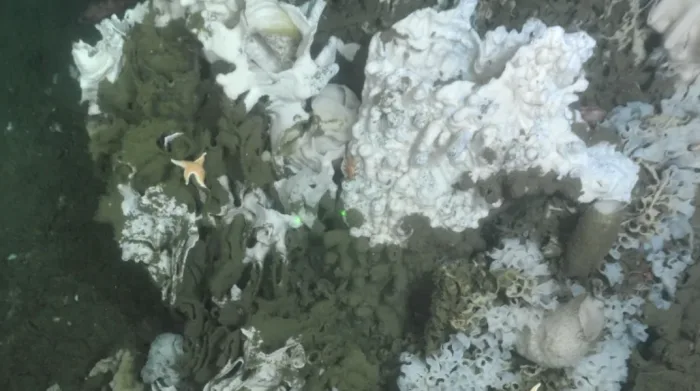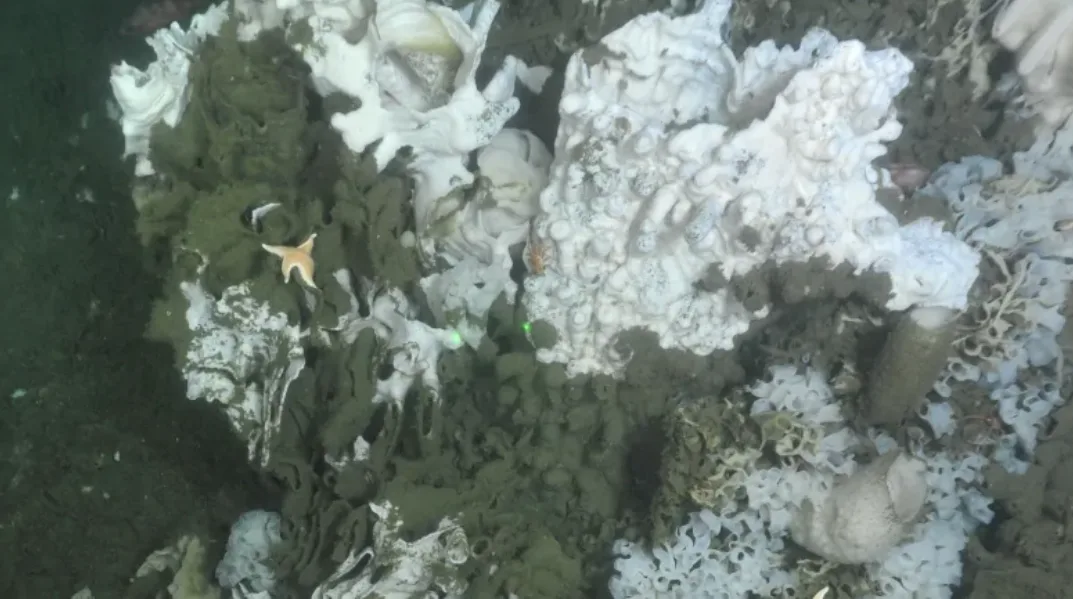
Scientists discover new species of sponge on deep-sea reefs off B.C.'s coast

Researchers from the University of Alberta have discovered a new type of sea sponge living off the coast of B.C. that is different from the glass sponges it grows alongside. Reseacher Lauren Law says the new species, pictured here in the top right corner, is bone white in colour and grows on the surface of glass-sponge skeleton. (Sally Leys, Department of Fisheries and Oceans Canada & Remote Operated Platform for Ocean Science )
A University of Alberta research team has published a study on the discovery of a new sea sponge living off the coast of British Columbia.
The new species — called Desmacella hyalina — was discovered using an underwater robot that travelled along the ocean floor, surveying reefs and collecting samples.
Department of Fisheries and Oceans Canada biologist Lauren Law, who worked on the study as part of her graduate degree, says these new sponges are different from the glass sponges on which they grow.
Law said the encrusting sponge grows on top of the skeletons of glass sponges to create structures that can house marine life. This creates better habitats than the muddy, ocean floor.
"Without them, it would be like organisms or animals in the bottom of the ocean floor trying to live in little huts versus living in condominiums," she said in a phone interview.
These structures provide habitats for rockfish, shrimp, crabs and halibut.
RELATED VIDEO: WHY CANADIAN SEA SPONGE RESEARCH IS SO IMPORTANT
EFFECTS ON GLASS SPONGE REEFS
The goal now, said Law, is to figure out if the new species is affecting the building of delicate glass-sponge reefs that are unique to Western Canada's coastline.
In February 2017, the federal government designated the Hecate Strait and Queen Charlotte Sound region as a marine protected area in order to preserve the deep-water reefs, which are estimated to be as old as 9,000 years.

*The reef formations provide homes for many marine animals, like rockfish, halibut, and crabs. The new encrusting sponge can be seen in the bottom right corner of the picture. (Sally Leys, Department of FishLaw said it's been suggested that the newly discovered sponge could have a negative impact on reef development and regrowth by competing with juvenile glass sponges for space, but it's hard to tell what damage has been done because the sponges repair themselves at a very slow rate.
She said the University of Alberta will continue to study the complexity of the sponge structures to better understand the underwater ecosystem.
"One of the most important reasons for studying the diversity of sea sponges in our oceans is for conservation management," Law said in a statement from the university.
"Many studies in the protected area have focused on describing the crustaceans and fish living in the reefs, but non-reef forming sponges remain overlooked." eries and Oceans Canada & Remote Operated Platform for Ocean Science)*
Law said it's been suggested that the newly discovered sponge could have a negative impact on reef development and regrowth by competing with juvenile glass sponges for space, but it's hard to tell what damage has been done because the sponges repair themselves at a very slow rate.
She said the University of Alberta will continue to study the complexity of the sponge structures to better understand the underwater ecosystem.
"One of the most important reasons for studying the diversity of sea sponges in our oceans is for conservation management," Law said in a statement from the university.
"Many studies in the protected area have focused on describing the crustaceans and fish living in the reefs, but non-reef forming sponges remain overlooked."
This article was written for the CBCby Ashley Moliere.










